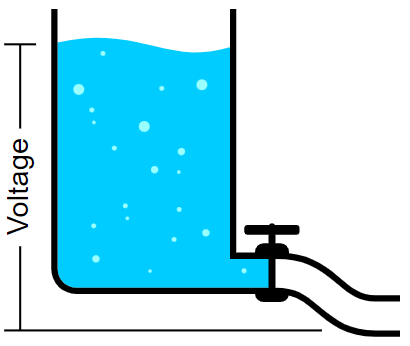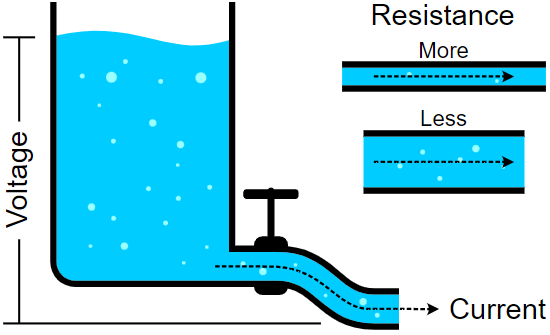Voltage (U) is one of the most important terms in electronics and electrical engineering in general. It is crucial to understand what it really is and the potential dangers that can arise from high voltage.
Voltage, often called electric pressure or electric tension, is the difference in electric potential between two points. Think of it as the push that makes electric charges move. In simple terms, it’s like the difference in height between two points in a river, which causes water to flow from one point to another. The unit for measuring voltage (U) is the volt (V).
Voltage can be created by storing electric charge like in a battery or capacitor or by generating it like in a power plant on a larger scale. Voltage differences can come from chemical reactions in batteries, squeezing certain materials to create electricity, or heating different metals joined together. Essentially, voltage is a measure of how much potential energy is available to move electric charges from one point to another. These electric charges can do work, for example, lighting up a bulb when pushed through it.
ANALOGIES FOR BETTER UNDERSTANDING
To understand voltage, using a few analogies can be very helpful. One suitable analogy is a tank filled with water up to a certain level (high potential). This water tank has the potential to let water flow through a hose to the ground (low potential).
This difference in height between the water level in the tank and the ground level is analogous to voltage (potential difference).

If the valve is opened, water will start to flow through the hose because of the water level in the tank. This is equivalent to the flow of electric charge in a conductor (such as a copper wire) due to voltage (potential difference).
Depending on the diameter of the water hose, there will be less or more resistance to the water flow. The same is true for the flow of charge in a conductor: a larger conductor has less resistance and can carry more current.

As the water level in the tank decreases, its potential also decreases, and the water current is not as strong as it was at the beginning of the discharge.
Similarly, a battery experiences a decrease in voltage as it discharges. For example, when a mobile phone battery discharges, it’s similar to the water tank’s water level going down. When the mobile phone battery is recharged using a battery charger, it’s like filling the tank with water using a water pump. If you want to know more about batteries (and their discharge profiles) check this dedicated category: Electric Batteries.
Another suitable analogy is an object thrown from different heights. Objects at higher altitudes have greater potential energy, which means that if they are thrown and hit something on the ground, the damage will be greater when the object is thrown from a higher altitude.
For example, if a bowling ball falls from a coffee table to the ground, it will probably cause some damage to your floor. However, if it is thrown from ceiling level, your floor will likely suffer much more damage. The table level can be figuratively compared to a 12V car battery, while the ceiling level can be compared to the voltage of a power outlet. Keep in mind that power outlet voltage can be extremely lethal !
TYPICAL VOLTAGE LEVELS AND POTENTIAL DANGERS
EXTRA LOW VOLTAGE:
AC <50V
DC <120V
Battery Operated Devices: 1.5V (AAA, AA batteries), 3V (coin cell batteries)
USB Port: 5V (standard USB)
Consumer Electronics: 3.3V, 5V, 12V (internal circuitry and peripherals)
While not typically fatal, these voltages (AC <50V and DC <120V) can still cause electric shock, especially if they involve direct contact with wet conditions or if they disrupt normal heart rhythm. Therefore, all precautions should be taken into account at all times.
LOW VOLTAGE:
AC 50-1000V
DC 120-1500V
Household Mains: 120V, 230V, 240V AC
Industrial Equipment: 400V, 480V, 600V, 690V AC
Electric vehicles: 400V, 800V DC
These voltages can cause severe electric shock, potentially leading to serious injury or death. They are commonly found in household mains and some industrial equipment.
HIGH VOLTAGE:
AC >1000V
DC >1500V
Power Transmission: Thousands of volts, typically 110 kV, 220 kV, 400 kV AC
High voltages are extremely dangerous and can be lethal. They are commonly associated with power transmission lines, electrical substations, and industrial machinery. Direct contact with high voltages will result in severe burns, cardiac arrest, and other life-threatening injuries.
All above mentoined voltage levels can vary based on regional standards, applications, and specific requirements of equipment and systems. Understanding these levels is crucial in designing, operating, and maintaining electrical and electronic systems safely and efficiently.
Understanding voltage is crucial, especially given the potential dangers associated with voltage (potential difference). Voltage can cause severe electric shocks, leading to serious injury or even death. However, with proper knowledge and safety measures, these risks can be mitigated.
For us, the most important is the DC extra-low voltage level because this is usually the voltage level area for electronic devices and industrial automation. All our projects will deal with DC voltages below 50V, mainly supplied from batteries.


Leave a Reply